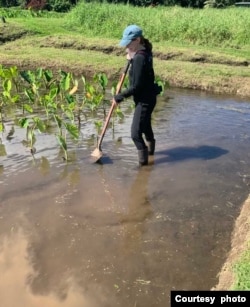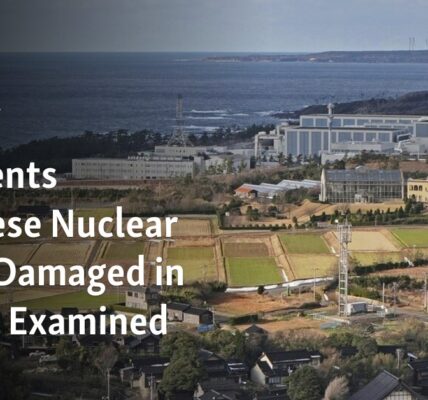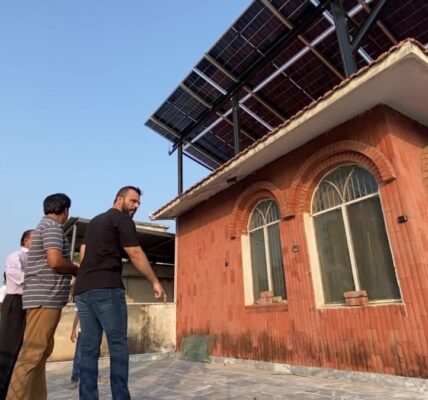WASHINGTON —
Audrey Gray was at a national task force in New Orleans when a colorful zine caught the climate journalist’s eye.
Produced by Imagine Water Works, the zine — A Queer/Trans Guide to Storms — took the form of “love notes” to the southeast Louisiana LGBTQ+ community, alongside practical storm preparation tips.
As a climate change journalist from Los Angeles, Gray had been reporting on similar content, with an emphasis on how communities adapt to change and protect themselves from extreme weather.
The magazine, she said, had useful practical information.
“Say you’re going through a transition right there: how to deal with your medication, what to take in your evacuation bag, how to plug into resources that will help you,” Gray told VOA.
Gray studied at Columbia Journalism School with the intention of being a climate journalist. Since graduating in 2019, her focus has been writing stories that would make people “feel something” about the issue.
“I had been freaked out by climate change really early,” Gray said. Her first stories focused on carbon emissions, but slowly she shifted to covering solutions rather than just the problems.
“I really wanted to try to advance the narrative in a way that focused on courage and acts of protection,” said Gray.
As a freelancer, Gray’s work has appeared in media outlets including Mother Jones and Wired. Now, as one of the three 2024 grantees for the Kim Wall Memorial Fund, Gray plans to expand her coverage.
Established by the International Women’s Media Foundation, or IWMF, the fund commemorates Kim Wall, a Swedish journalist killed off the coast of Denmark in 2017 by a man she was interviewing.
Each year, the IWMF awards grants to female or nonbinary journalists who focus on lesser-known stories that reflect Wall’s ideals.
Alongside Gray, this year’s grantees are the Netherlands-based documentary filmmaker Zhaoyin Feng and the U.K.-based freelancer Isobel Thompson.
Taylor Moore, an associate program manager at the IWMF, is part of the selection panel. She described Gray as “curious” and “excitable,” much like Wall had been.
“She’s able to distill the science in a way that’s understandable for the lay person and really shows the human impacts of climate change,” Moore said.
Noting that Gray is one of the few American journalists awarded a grant, Moore told VOA, “We thought this was a story that deserved equal prominence among the international stories we fund.”
Gray credits much inspiration to Wall, a journalist who she says was “ahead of her time.”
Wall was 30 when she was killed. But she had already made strides in media, traveling the world and writing about marginalized communities. Her work, Gray said, is what she admires about the young reporter.
“[Wall] would write stories about people, and climate change wasn’t necessarily the headline, but it’s all there,” said Gray. “She was really skillful at getting herself to a place and then pitching all kinds of stories from that place to different publications.”
Gray plans to use her grant to expand reporting on her most recent project: a feature on an emergency management network set up in Maricopa County in the southwestern state of Arizona. Around 500 people died of extreme heat in that region during the summer of 2022.
Set up in a historically Black Methodist church, the center helped the community cope with the deadly temperatures outside.
“It was only open six hours a day on the weekdays, but all the regulars would go in, and they would get a short break from the worst heat of the day,” said Gray.
With a growth in emergency centers following the pandemic and natural disasters, Gray is interested in expanding her coverage of aid efforts in the LGBTQ community.
She plans to look at what resources are available to marginalized groups.
One focus is emergency shelters in Arizona, a state that has extreme weather and where authorities are proposing anti-LGBTQ+ legislation.
“Usually, the first shelters that are set up are placed often in churches,” said Gray. But, she said, many of her sources describe having negative experiences in religious establishments, including rejection or abuse.
Other people she has interviewed described experiencing violence at emergency shelters and encountering people there who are uncomfortable with them.
Gray plans to feature organizations such as QReady, a group focused on emergency management and “amplifying” a sense of agency for the queer community.
“I’m not reporting on victims here at all,” she said. “I’m reporting on a community that is taking action to protect itself, and there’s this real spirit of ‘We can protect each other, we can create safety.’”
The IWMF selected Gray from 141 submissions sent in from more than 50 countries. It was the largest number of applications the foundation has received.
As the only journalist based in the U.S. to be selected, Gray says the grant is “so much more meaningful.”
The journalist says she has a “deep sense of resonance with [Wall] and a hope that more people will learn from her and put some of her good practices to work.”
For Gray, that will include continuing to highlight the stories of people persisting against climate change and protecting their community. “I feel like that’s why I’m here,” she said.
Source: voanews.com




